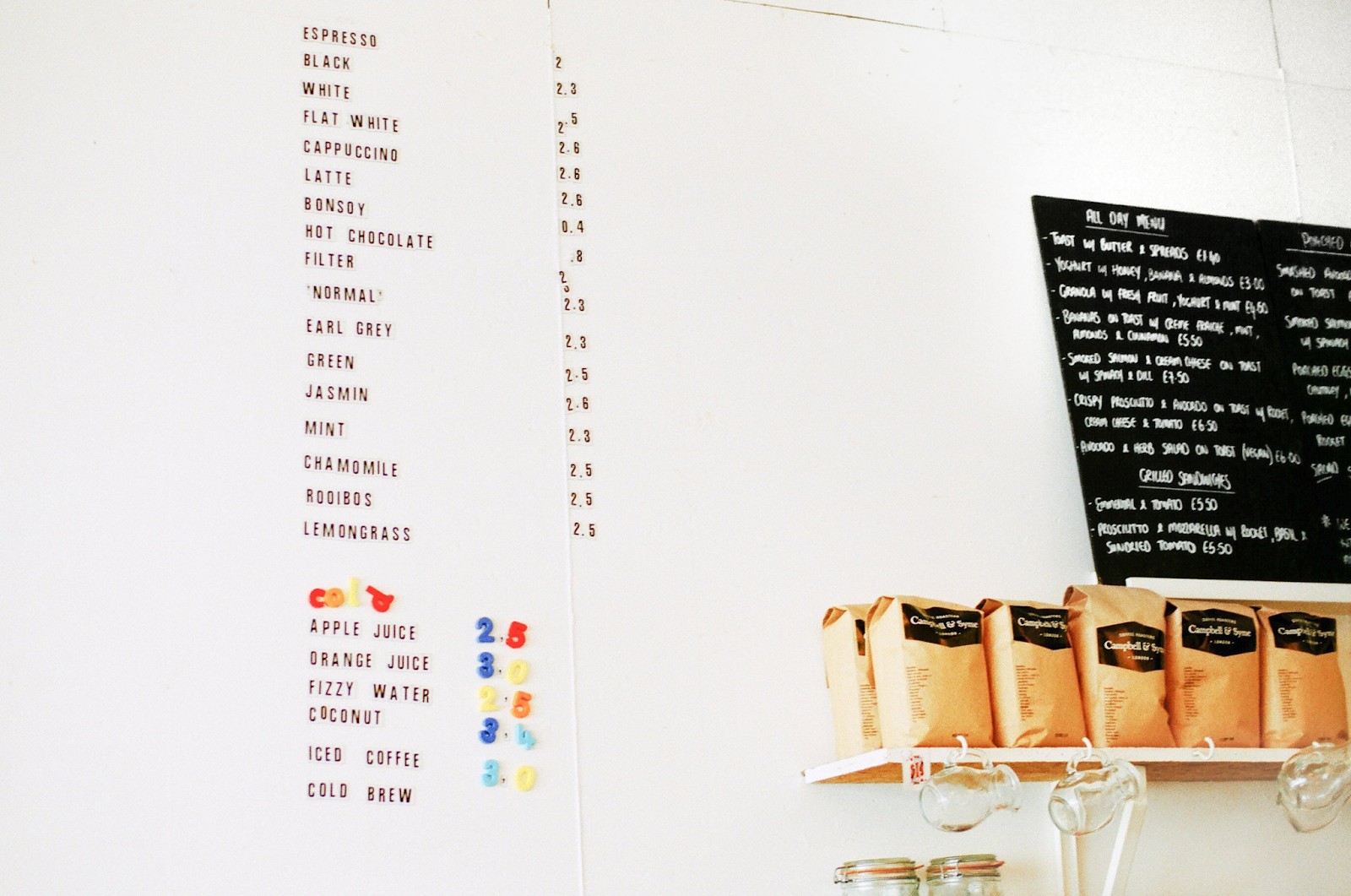
Once you discover your love for coffee and why you want to share your love for coffee, it’s time to work into the finer details. Remember, the same old flavors in the same old drinks are simply not going to cut it. When it comes to crowd favorites, larger coffee shop chains like Starbucks are going to out of class you in every single way.
For any business selling food or drinks, no details should be spared when it comes to making the menu. This is especially true when it comes to your coffee shop – presentation matters as much as the contents and the ingredients.
However, despite the demand for coffee, many shops can easily overlook the menu. First-time owners can easily fall into the mistake of adding too few drinks that are bog-standard and unoriginal or add too many difficult specialty drinks that not enough customers order.
There are a few things to keep in mind when making the best menu possible for your coffee shop, and knowing these beforehand can give you a big head start.
What’s on the menu at your coffee shop?
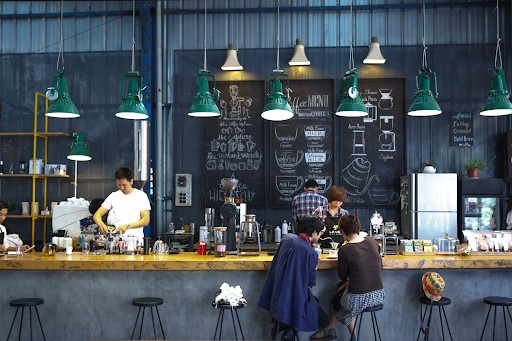
The choice of drinks, of course, is the first and most important part of the menu. This is the selection of the items that you’re going to sell in your cafe, so it’s worthwhile to break it down in as much detail as possible.
For your coffee shop, you are going to want to bring something new to the table, something that is uniquely identifiable to you. That doesn’t mean that you are not going to serve a classic latte, cappuccino, macchiato, or Americano — but that doesn’t mean that you cannot add a little bit of a twist to all of these drinks. Try to be as unique as you possibly can because remember, it is all about being consistent with your brand personality.
One way to do this is by visiting different coffee shops and looking at their menus as much as you can. You should also look up shops online both in and outside your area, and different cafes all over the world can give you all kinds of unique and novel ideas.
If you’re not sure where to start, you can find the following items are staples in nearly every coffee shop menu:
- Coffee/espresso – The most basic foundation of any coffee shop is, of course, the coffee, without any added milk or sugar. When brewed correctly, the beans speak for themselves.
- Specialty drinks – Your lattes, cappuccinos, and macchiatos need not be tricky to navigate and add to your menu. With the right selection, they can bring out the message that your brand is trying to say.
- Non-coffee drinks – Offer other non-coffee choices to add some variety to your menu, whether it’s chocolate, matcha tea, or coffee cocktails.
- Side dishes/snacks – Whether it’s desserts, pastry, or pasta, having a side dish to go along with the customer’s drinks is great for the complementary flavors, aroma, and texture. These all aid in unlocking the full experience.
- Coffee bags – Regular customers, hobbyists, and aficionados are always on the lookout for great beans to brew at their leisure. This can be a great way to both promote your partnership with roasters and coffee farms, as well as move excess inventory.
When making specialty drinks, it’s important to consider the demand for them. Following trends can be a great start if you time it right, but what you serve should be in line with your brand and attract your target market.
You should also note things like sizes, optimal temperatures, milk options, and flavors that customers may prefer over others. For sizes, you can take the average from different coffee shops and decide if you want to stick to that or offer just a little more quantity.
These are the most common specialty drinks you can see being ordered in coffee shops, from your small-time specialty shop to the Starbucks in your local mall:
- Cappuccino – This is a coffee drink consisting of espresso and milk foam, served in a cappuccino cup.
- Caffe Latte – This is “milk coffee”, which is an espresso shot with steamed milk and a small amount of milk foam poured on top of it. Flavored syrup can be added as an option.
- Caffe Mocha – This is a caffe latte with both chocolate and whipped cream, made first by pouring chocolate sauce, followed by a shot of espresso and steamed milk, topped off with whipped cream and a sprinkling of chocolate.
- Frappe – This is an iced coffee made of espresso, milk, and ice mixed in a blender with flavored syrup and served in a latte glass.
- Macchiato – The difference between a macchiato and other specialty drinks (i.e. cappuccino or caffe latte) is the ratio of milk. A macchiato is essentially an espresso with a smaller amount of foamed milk.
Don’t underestimate the power of a humble croissant or breakfast sandwich! No matter how simple they seem at first glance, they elevate your coffee and attract more customers than just coffee alone. While they’re great separately, they’re even better when paired together.
Snacks are also where you can be a little more creative in your approach. The great thing about coffee as a drink is its versatility – you can pair it with so many types of food that cater to tastes that can be as broad or as specific as you want to go for.
To give your customers the best of both worlds, keep these amazing food and coffee pairing tips in mind:
- Fruit pairings – Fruits, or at least fruit-based foods, give a citric-sweet tone on top of being a healthy option, but watch out for the sour notes!
- Pastries – Sweetbreads go well with almost any coffee, especially a hot espresso on a good afternoon.
- Savory baked goods/cheeses – These are always great go-to choices or any cafe, so it comes down to full-bodied brews to bring it home.
That said, these aren’t necessarily hard and fast rules. Feel free to experiment with different pairings to find out which one works best for your menu!
What makes your coffee shop’s menu different?
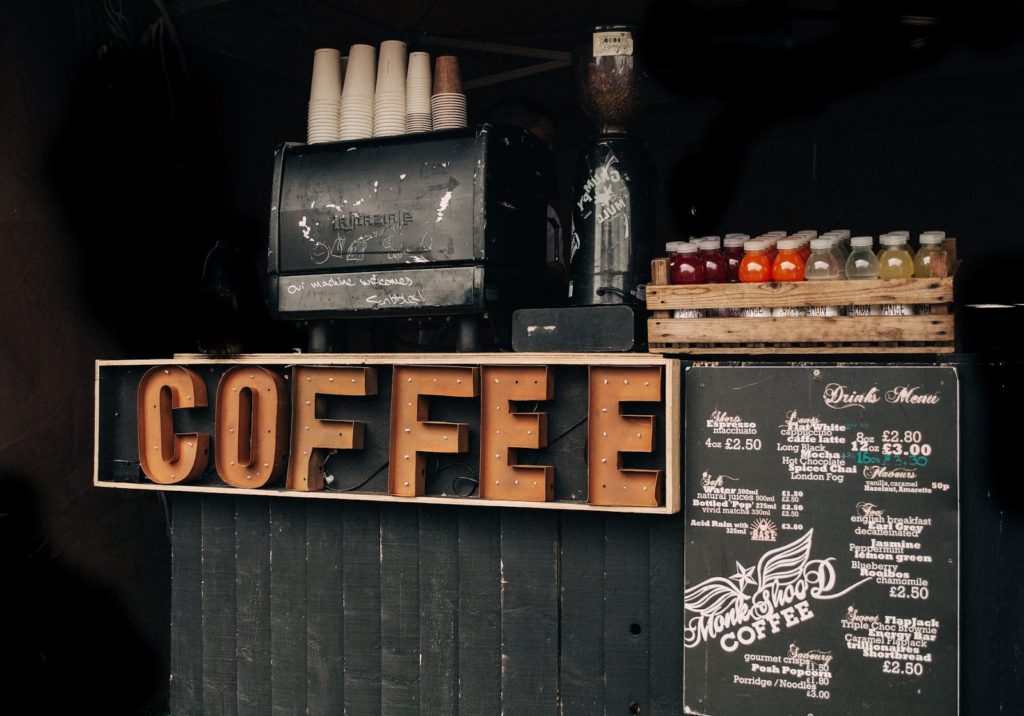
Your menu is a big part of what your business, and your brand, will look like to potential customers and future patrons. Now that you have an idea of the things you can put in a menu, it’s time to take a look at things that your competition already has on theirs.
For instance, if your competition specializes in sweet coffees, you might want to explore the other flavors and aromas that coffee can offer, so it would be better to go with different bean varieties and darker or medium roasts.
Coffee cocktails are another fantastic way to explore how the coffee experience can be enjoyed. If your competition advertises a more relaxed, quiet environment, you might want to present your coffee shop as a livelier one where people socialize after work hours.
These all play into the brand that you want to present, so there’s all the more reason to take your time and try out different varieties you like.
That said, there’s no harm in adding a few items that every coffee shop has on the menu – the tried and tested all-time favorites should, instead, be seen as a way to sell what makes yours different, and therefore special.
What should your menu look like?
Menu design and layout should be just as important as the contents of your menu. Both can have a significant impact on customer spending and are just as much a subtle method of effective advertising for your brand as merchandise.
Here are a few pro tips for making a great design and layout for your coffee shops’s menu:
- Put the simplest menu offerings first, and the more complicated ones in the later sections. These are the most familiar choices for customers, and seeing them right away makes them more likely to order.
- Keep your logo simple, but not oversimplified. It has to be something both memorable and legible,
- If you want to make a menu board displayed above or near the counter, using a chalkboard can bring out your inner creativity with little drawings on the side.
- Well-placed graphics and pictures show off what you have to offer. Don’t be afraid to use them, but be sure to balance them out!
For printing out menu booklets, it never hurts to put your ideas on scratch paper first. Having drafts to reference will give you a rough idea of where to place the elements you want present, and which elements to leave out.
Don’t feel overwhelmed about the various elements of graphic and visual design – you can always reach out to a graphic designer or a layout artist with ample experience to do the lifting for you.
Alternatively, there are many great resources for you to check out online if you want to design the layout for your own menu. Simply click, fill in the list of items, and get what you need.
Where do I get my coffee beans for my shop?

Cafes tend to offer larger bags of whole beans that they can grind on a daily basis to keep them fresh, while restaurants go for the pre-ground options to get their coffee out faster in exchange for quality. As a coffee shop owner, buying in bulk from wholesale sellers is the way to go.
There is a difference between local and imported beans: with the latter, the process tends to be more straightforward. Importers are more likely to sell in bulk, and so if you can find a potential lead, check in to see if you can sign up for a sampling event where you can place your order.
If you want to get into specialty coffee, it might be worthwhile to partner up with local farmers and roasters if you can get past the paperwork. Sourcing your beans locally is great for boosting trade and supporting these businesses.
On top of this, you also establish connections with other local farmers and roasters, which in turn give you access to more local bean varieties.
There are three different categories you’ll see when you shop for your beans. Countries, regions, plant variety all have a hand in the coffee bean’s aroma and flavor, and this can set some brands of coffee apart from others. These are:
- Blend – Blends are a mixture of different varieties of coffee beans. For instance, arabica and robusta beans are often added together in a single blend to give them their distinct flavor and aroma.
- Single-origin – These are coffee beans that come from a specific region or farm. What sets them apart compared to other coffee beans is how they are grown, such as climate and soil type.
- Micro lots – These are coffee beans that come from specific sections of a particular farm.
Single origins are especially beloved by aficionados looking for specialty coffee (e.g. Guatemalan or Rwandan coffee), but they can be expensive compared to other varieties. Micro lots can be just as expensive, if not more.
Blends can also be a good option, where different beans with different flavors balance and complement each other. Don’t be afraid to try them out just because they combine different varieties from different regions.
There are also roast profiles to consider when you choose the right beans for your shop. In a nutshell, the roast profile is the attributes of a coffee determined by things such as temperature and roast time. Look out for the following:
- Aroma – This category has to do with the smell. Is the roast flowery, nutty, or smoky? Lighter roasts preserve the fruity notes, while darker roasts increase acidity and smoky notes.
- Taste – Acidity, sweetness, and even sourness tend to depend less on the roast time and temperature, and more on the bean variety. However, darker roasts tend to bring out more toasty, bitter notes.
- Body – Body is the coffee’s specific texture and mouthfeel. Bear in mind that this is the sensation, rather than the flavor itself.
On a similar note, different types of roast can also affect the resulting brew:
- Light roast – A light roast highlights fruity and acidic flavors, which many specialty coffee drinkers tend to prefer over medium and dark roasts.
- Medium roast –This type of roast is defined by balance. Medium roasts tend to be smoother and highlight faint elements of darker roasts without overwhelming the bean’s otherwise natural oils and flavors.
- Dark roast – While dark roasts tend to have a bad reputation as a way to cover up bad tasting coffee, it does highlight bitter and toasty notes, as well as a fuller body compared to the other types of roast.
One more thing to note when reading the label is the difference between fair and direct trade. “Fairtrade” essentially means that the farmers or producers of that coffee bean were paid an amount above the international price (this may not always be a living wage).
Meanwhile, “direct trade” involves the roaster buying directly from the coffee farmer, though this can be difficult to know exactly since it may just be marketing in some cases. Be sure to do your research before making your purchase.
Aside from just beans, you should also keep brewing equipment in mind. Having customers who are used to espresso-based drinks means you will at least need a grinder, if not an espresso machine.
If you want to cater to more specific tastes, here are a few types of equipment you should look into for your coffee shop:
- Coffee brewer – While there are plenty of types to choose from, the humble coffee brewer is crucial for any average coffee shop to bring coffee to its customers.
- Airpot server – Satellite brewers and airpot servers keep coffee heated longer than glass decanters. If you want to try a self-serving station, go for this one.
- Hot water dispenser – Even though coffee machines can come with their own built-in faucet for hot water, having an available supply of hot water clears up busy queues by letting you fill multiple mugs at the same time.
- Espresso grinder – Grinding beans just ten minutes before brewing can significantly affect the flavor. Having a grinder lets you make freshly ground coffee, with a greatly increased surface area and all the soluble oils that give great coffee its distinct taste.
- Ice machine – Iced coffees, smoothies, and other specialty drinks will need ice, so it’s important to have one that keeps your ice cubes ready to go at a moment’s notice.
Grinder quality is also an important factor when it comes to brewing quality coffee. In fact, having a uniform grind size at a reasonable speed is crucial for keeping each mug of coffee consistently delicious despite busy hours.
How much should I charge for coffee shop menu items?
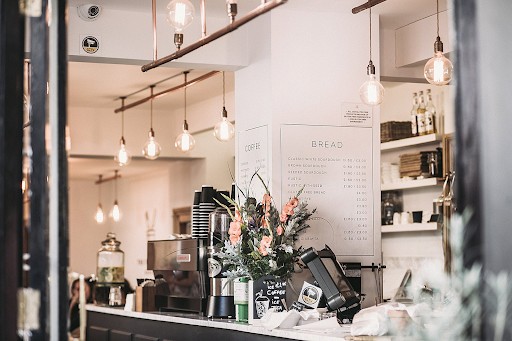
Prices are important. If your coffee is too cheap, you end up underselling its value and giving customers the wrong impression. However, if it’s too expensive, your target market may be priced out and opt for competitors who offer a more affordable alternative.
The best way to go about this is by doing a little research. Find out how much competitors charge on average for a cup of coffee and determine if you want to charge a little less, or a little more.
On top of this, it also helps to consider the cost of materials when pricing your products. Calculating the optimal price per mug based on how much your beans cost is a great way to start. Other factors include the following:
Material costs
Direct costs (i.e. labor and supplies) and indirect costs (i.e. rent, taxes, heating, and repairs) should factor in the prices to give you an estimate for your target weekly average sales.
Seasons and events
Seasonal items can be added and priced at a premium since they are an additional experience that consumers are more willing to spend on due to their rarity.
Location
Where are you located? Rent is a strong factor you should consider as part of your indirect costs. If you’re operating in an area with more than one coffee shop, you also need to factor in the average prices of your competition.
Market
Who’s buying? If your target market is working adults, you may be able to get away with pricing drinks a little more, but if you’re located near a university, your target market will want more affordable options.
More menu tips for new coffee shop owners
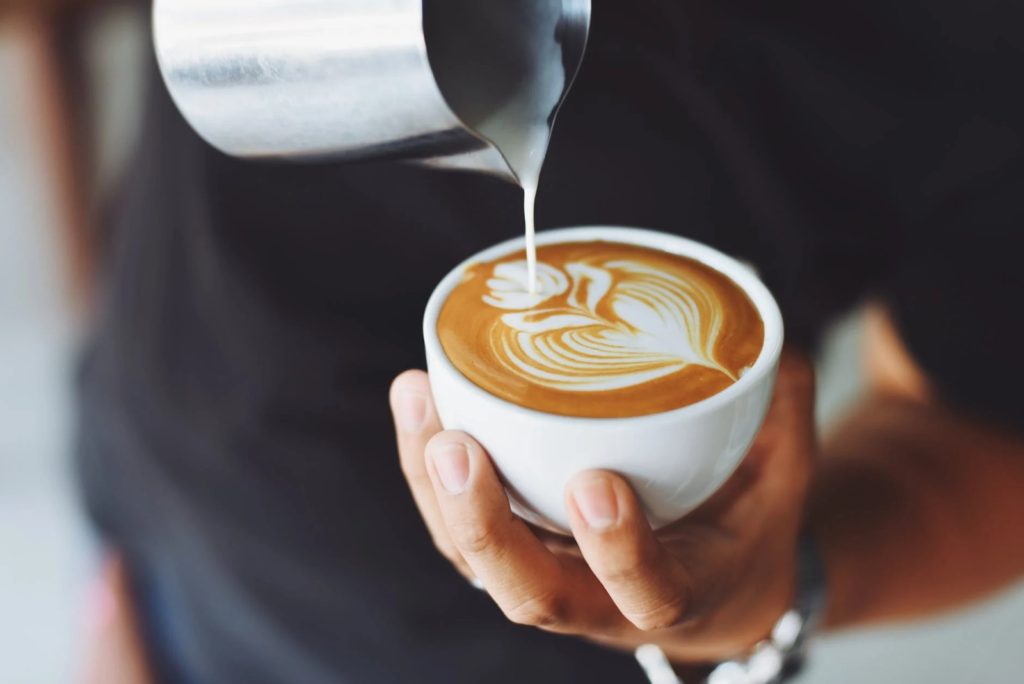
When coming up with a business plan and the menu for your coffee shop, there are common pitfalls that you need to avoid. Here are a few pieces of practical advice you’ll need to hear when opening your coffee business for the first time:
- Do your homework – Everything from beans to business hours depends on the demands of your target market. This is where even just a little bit of research really comes in handy.
- Simplify your menu – Having too many items to anticipate your customer’s every need is a common mistake any new coffee owner can make. It’s best to pare it down to a limited selection of drinks that you know everyone will regularly order.
- Skip the cheeky names – Cafes are plentiful, and having another coffee shop based on a pun makes it harder for you to distinguish your brand. Instead, make your name something that captures your environment and is true to your vision.
On top of this, you also want to keep the following management tips in mind once you’ve found your footing:
- Automate your inventory – Keep recurrent expenses in check by having an efficient way to check your invoices regularly. This can give you a rough estimate of how often you buy certain stock items and determine your most popular products.
- Embrace technology – While hand-made artisanal coffee shops can still do well, they are few and far between, especially in areas with high foot traffic and long queues. Aside from point of sales (POS) systems, technology can get coffee out to more customers faster and with less effort from you and your staff.
- Don’t skimp out on employee training – Coffee shops, much like other businesses, have their own practices and skill requirements. Training and retraining new and long-time employees can greatly improve and refine their skill set.
A well-managed and effective coffee shop with a great menu and a great atmosphere is one that customers will remember and want to frequent. Paying attention to the details and encouraging your employees to do the same can help your business go above and beyond.
Because there is so much information to consider, choosing the right selection of coffee and coffee-based drinks for your cafe can be more complex than it lets on. Fortunately, with the right know-how, there’s no need to be daunted at the prospect.
Get out there and start brewing!

